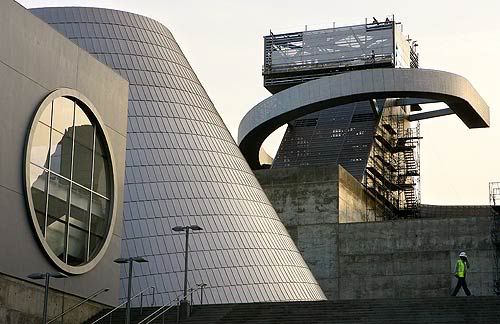Saturday, December 27, 2008
Air mail special delivery
I'm heading out of town for a few days; might do some light posting if I find an internet connection at my destination. Otherwise, see you back here after New Year.
Best wishes to you all for 2009.
Wednesday, December 24, 2008
Monday, December 22, 2008
Art's uncivilizing mission

Steel roller bearing factory, XiangChun, China
Inspiring, isn't it? Ugliness is truth, truth ugliness; that is all ye know in the Los Angeles Unified School District, and all thy students need to know.
Central High School no. 9 is a source of pride, the Los Angeles Times reports — "believed to be the second most expensive public high school ever built in the United States," and located in the state that is rattling the tin cup in the halls of Congress because it has never turned aside a money-gulping project.
And why should it? Californians know they are made of finer stuff than the common cloth, live in God's multi-cultural paradise. Steven Spielberg tells them so. Besides, Central High School no. 9 is a blockbuster. Literally: it will transform a seedy patch of downtown L.A. into a "campus" with star quality.
Few will question whether the campus itself is capable of fostering excellence. At a cost of $232 million, it is one of the crown jewels of the Los Angeles Unified School District. That's clear from the moment you pull into the multilevel, 300-car garage. Up a broad flight of stairs, the campus' main buildings offer three dance studios with sprung maple flooring. A professional-quality, 950-seat theater. Music classrooms with acoustic tiling and special whiteboards designed for musical notation. Floor-to-ceiling windows with motorized blackout shades. Ceiling-mounted projectors in every classroom, allowing teachers to display lessons from computers.I don't know what the Iron Giant is (probably a reference to a character in the kind of movie I avoid), but by gum, I'm impressed. A 300-car garage. Track lighting. A library cone — will it have any books, or just DVDs? — with a kinky skylight. Kewl.
Track lighting in the hallways to illuminate student art. An outdoor atrium for firing Japanese raku pottery. And the school's centerpiece, a conical library whose dazzling interior swirls upward to an off-center skylight. All that, and a tower that looms over the 101 Freeway like a severed limb of the Iron Giant.
Imagine what Beethoven and Rembrandt might have accomplished with such lavish facilities at their disposal in their tender youth.
But, the United States being the United States, and L.A. being L.A., there's trouble in this "expensive social experiment," as the Times calls it. Everything is political. The school was designed as a plum for a "community … in which we have thousands of very talented students but who lack the social capital and the access to quality arts training," as a school superintendent says. Translated from sociological jargon, that means it was intended to draw its students from inner-city 'hoods and turn cinder-block-wall graffiti artists into canvas graffiti artists.
But some school board members think this gem of a school should have an outreach program to recruit students from less deprived areas. Others will have none of that.
"For 27, almost 30 years, these kids have had a 65% dropout rate, a very limited outlook for their future," said Maria Casillas, president of a nonprofit foundation that promotes parental involvement in schools and a member of an advisory board established to support the arts high school. "And I don't know that the cost of these buildings actually pays for the pain and suffering that we have created . . . for these kids."Ms. Casillas, don't get me wrong, I know we can never make up for our failure to tax ourselves from here to the moon so we can provide welfare to these underserved communities, bestow citizenship on every cute little niño and niña born at public expense, treat the community for free in hospital emergency rooms, launch a hundred programs to persuade the youth of Aztlan to take up midnight basketball instead of gang banging, but … who is "we"? Have "we" run public service adverts on radio and TV, placed ads in buses, urging Jose and Estella to drop out of school? What exactly is the pain and suffering that "we" have created for them?
Anyway, here's your $232 million high school. It's a start. Try to find it in your heart to forgive us.
Wednesday, December 17, 2008
Why, Cleopatra, I hardly recognized you
So glad you kissed off the cobalt eye shadow and the bangles and that Eye of Horace bit. Let's face it, dear, your PR director had been dropping the ball lately, but now she's positioning you as a diversity totem, you're back on the historical celebrity A List. You go, girl!
You'll want to get a Facebook entry straightaway — be sure and include me as a friend! And put that guesstimate about your ethnicity bang up front, it'll do wonders, trust me.
Tuesday, December 16, 2008
No, Virginia
Ms. McConnell said:
Now we are at a crossroads. Companies that survive this economic downturn must continue the transition toward greener vehicles. But this transition will be neither quick nor cheap. Recently passed fuel economy standards are a step in the right direction, but high gas prices are essential. They provide incentives to manufacturers to produce the new generation of vehicles, and for consumers to buy them. The recent run-up in oil prices showed us what a powerful force the market can be in influencing purchase decisions and spurring innovation. Now, with gasoline back to $1.50 a gallon, sales of hybrid vehicles are faltering.So, let's stop expecting the car companies to protect us from ourselves. If we want less dependency on foreign oil and reduced greenhouse gases, we'll have to put policies in place to achieve this. If we do, the automakers, whichever ones remain, will figure out how to get us there.
The trouble with think tanks is that they don't think much, at least not outside their laser-like focus on the particular issue that makes their heart beat. It's called single-valued logic: you rivet yourself onto one goal, which might be good in itself, and the context and all competing goals melt into air, into thin air.
Virginia, pull your head out of the clouds for a moment and look around you. I know it's hard to take this aboard, with you having a no-doubt secure and well-paying foundation job, but quite a few of those slugs who need to be saved from themselves are going through a sticky patch. Many of them are not as well connected as you, hence they have no visible means of support at the moment. Lots of others will get no raise or bonus to spike the punch at the office party this year.
There are also quite a number of poor working people in this country who depend on their cars to get to their employment sites, and for whom more expensive fuel could be a personal disaster.
For all of these lesser breeds without the environmental law, the merciful fall in gas prices is the only economic blessing they have to count.
But that's too good for those swine, in your enlightened view. They stand in the way of reaching the Promised Land where everyone will drive little kiddie cars or, better yet, be packed into sediment on public transportation. There's no way individuals or car manufacturers will do the right thing based on their own needs or good sense, so we've got to wheel up the Big Gun of the government and put it to their heads.
You think it's a disaster that our government lacks the moral fiber to tax its citizens till they bleed from the ears and surrender to the supreme wisdom of the State. I happen to be proud of the fact that, at least for now, I have the privilege of mobility and can afford it. Incidentally, Ms. McConnell, even when gas was at a dollar and change a gallon before the big run-up, I bought a fuel-efficient car no larger than was practical for my needs.
You see the big picture — environment! With environmental needs so pressing, people can't be trusted with outdated ideas like liberty. Well, there's a bigger picture. It includes both the environment and (excuse the expression) the choices of individuals.
Monday, December 15, 2008
Congress debates Bernie Madoff bailout
You read it here first.
UPDATE 12/16
Surely $50 billion makes him too big to fail.
Great line from a commenter at Marketwatch: "The market has nowhere to go but up. Everything, including the end of the world, has been 'priced in.'"
Saturday, December 13, 2008
G'day, mates! Drop dead.
DISCRIMINATION against dominant white males will soon be encouraged in a bid to boost the status of women, the disabled and cultural and religious minorities.Such positive discrimination -- treating people differently in order to obtain equality for marginalised groups -- is set to be legalised under planned changes to the Equal Opportunity Act foreshadowed last week by state Attorney-General Rob Hulls.
You may have a chance, though, as long as you're a criminal. Not by being a white male, but by having committed a traditional criminal offense.
The laws are also expected to protect the rights of people with criminal records to get a job, as long as their past misdeeds are irrelevant to work being sought.Of course, the state of Victoria might consider that having been born with a Y chromosome and a melanin shortfall is relevant to any kind of work going.
My image of the Aussie bloke is being sorely tested. They'll be weeping a bit, sensitively, down at the boozer. "Crocodile" Dundee will sort out the muggers. "That's not a mop." (Whips out Bowie mop.) "This is a mop."
Mates, you can hide out halfway across the flaming outback, but the long arm of positive discrimination will catch you up like a 'roo with itchy feet. Can't think what you could do about it.
Tuesday, December 09, 2008
Tear it down
Friday, December 05, 2008
Canadian Marxmanship trophy
According to the Canadian Multiculturalism Act 2006–2007, "All federal institutions shall undertake projects or programs in respect of multiculturalism and carry on activities in a manner sensitive and responsive to the multicultural reality of Canada. Ministers of the Crown shall, in the execution of their respective mandates, take such measures as they consider appropriate to implement the multiculturalism policy of Canada."
We are in complete harmony with the Directive. As Director, Ethnocultural Services Section, Offender Programs and Reintegration Branch, I am pleased to present this submission by the Correctional Service. It is of course available in French and 49 other languages.
Q. 2.1 Does your institution's vision, mission, mandate and/or priorities statement(s) include reference to multiculturalism?Yes, Commissar, a thousand times yes! Your vision is our vision! Consider, if you please, Commissioner's Directive 702 on Aboriginal Programming: "To ensure that Aboriginal Offenders are provided with an equitable opportunity to practice their culture and traditions without discrimination and with an opportunity to implement traditional Aboriginal healing practices."
Q. 2.3 Does your institution have programs related to multiculturalism?Glad you asked me that, Sir! We consider these programs to be our core mission. Let me give you just a few examples.
"In Ontario, we have contracted with the Black Inmates and Friends Assembly to provide a variety of programs to Black inmates and other ethnocultural groups including the provision of ethnocultural programs and services to ten institutions as well as to provide contact between ethnocultural communities in the Ontario region and federal offenders indigenous to those communities to assist in their successful reintegration back into their respective communities. Specific activities include the provision of training to staff, meetings with ethnocultural groups, establishment of volunteer visiting programs, creation of a network of volunteers from the different communities to work with offenders in the community."
That's only one token of our ethnoculturally centred outcome-directed inclusiveness drive. Take another: "Five new positions will be created for the coordination of ethnocultural services in all regions." Or this: "Inuit Programs on substance abuse are being provided by an Inuk Elder." And people imagine that all we do is keep criminals from preying on them. In fact, I am putting in our budget request for the next fiscal year a proposal to fund a public educational program to increase awareness of how we are at the leading edge of Canada's multiethnic inclusive sensitivity initiative.
Q. 3.1 Did your institution undertake initiatives to foster a corporate culture that embraces diversity?Does an Inuit club baby seals? Excuse me, that just slipped out. I meant of course, Commissar! I am proud of our proactive, multiethnic solutions-based actions. Let me just bring you up to speed on a few. If you'll turn to page 43, you'll see the following: "In order to encourage staff and recognize their efforts in increasing cross-cultural awareness and sensitivity toward ethnocultural diversity and improving race relations, a multiculturalism award has been created. The award consists of a citation signed by the Deputy Commissioner or Assistant Commissioner and the Deputy Minister of Canadian Heritage. It is awarded every year on March 21; International Day for the Elimination of Racism." Bingo!
Or — you'll pardon me if I swell with pride a little — how about this: "In Atlantic region Watoto an event organized to raise $27,000 to build a house in Africa. Many activities surrounding African-Canadian culture such as African Children's Choir were organized at Nova - prison for women in April 2007." Kind of takes your breath away, I know. But there's more: "Change of Seasons Gathering! Black History Month! Asian Heritage Month Events! Violence Against Women events! Human Rights Day Observance! Aboriginal Cultural Awareness Sessions/Forum!" And (I'm bound to admit to having had a hand in advancing this) "Talking Circles with Native Liaison Officer or Aboriginal Elder."
Q. 3.3 Did your institution undertake initiatives to celebrate Canada's cultural heritage with the general public?In a word — yes! "Under New Employee Orientation Program, in some regions, staff are offered the opportunity to participate in sweat lodge ceremony in one of the Aboriginal communities."
Correctional Service of Canada
Q. 4.1 Did your institution develop policies that took into consideration multiculturalism and diversity?Sir, you can take that to the bank. I direct your attention to page 77: "Personal Effects policy now has added culturally sensitive items such as hair care products. Policies must align with a Diversity and Cultural Sensitivity Checklist."
Q. 5.1 Does the workforce in your institution reflect Canada's diversity?Absolutely. Number of visible minority employees: 786!
I am in a position to assure you, Commissar, that a substantial number of these employees also meet guidelines for inclusiveness of women, differently abled, lesbian/gay/bi/transgendered warm and wonderful people. In reading the complete report, I am sure you will agree that we are fully meeting our responsibilities under the Multiculturalism Act. And we will continue to press for changes to the law mandating that ethnic and indigenous persons be incarcerated only in numbers that are exactly proportional to their representation in our great multicultural Canadian society.
Wednesday, December 03, 2008
Treasury island

Hair shirt, popular with penitent
medieval monks, in updated model.
Unlike the Mafia, established stock and commodity exchanges, like the NYSE and the Chicago Board of Trade, are entirely legal. But like the Mafia, they understand these dangers and have strict enforcement procedures to prevent them. When you want to purchase 100 shares of Microsoft, for example, you never buy directly from the seller. You must always go through a brokerage firm, which, in turn is a member in good standing of the exchange. The brokerage firm must keep close tabs on all its customers, and the exchange keeps close track of all its member firms. …As usual, before we buckle at the knees, let's remind ourselves that in financial forecasting no one is objective. Vested interests are everywhere. This gentleman has a newsletter to sell, and extreme positions attract more attention (like this posting) and perhaps more subscribers than a more cautious and hedged outlook. I am not suggesting Weiss is writing anything other than his honest opinion, but even honest opinions can be influenced by a person's situation.
For the most part, the global derivatives market has no brokerage, no exchange, and no equivalent enforcement mechanism. In fact, among the $181.2 trillion in derivative bets held by U.S. banks at mid-year 2008, only $8.2 trillion, or 4.5%, was regulated by an exchange. The balance — $173.9 trillion, or 95.5% — was bets placed directly between buyer and seller (called “over the counter”). And among the $596 trillion in global derivatives tracked by the BIS at year-end 2007, 100% were over the counter. No exchanges. No overarching enforcement mechanism.This is not just a matter of weak or non-existent regulation. It’s far worse. It’s the equivalent of an undisciplined conglomeration of players gambling on the streets without even a casino to maintain order.
With that out of the way, let's follow his views further:
This is why super-investor Warren Buffett once called derivatives “financial weapons of mass destruction.” This is why the top leaders of the world’s richest countries panicked after Lehman Brothers failed, dumping their time-honored, hands-off policy like a hot potato, jumping in to buy up shares in the world’s largest banks, and transforming the world of banking literally overnight.Unlikely? Probably, but today's headlines are full of events that would have been beyond unlikely a couple of years ago. Anyway, Weiss thinks that the smart thing to do now is go into full defensive mode, protecting your capital — not just against market losses, however severe, but against the temporary crack-up of the financial structure.This is also why you must now do more than just find a strong bank.
You also must find a safe place that has the highest probability of being immune to these risks. The reason: As I warned at the outset, at some point in the not-too-distant future, governments around the world may have no other choice but to declare a global banking holiday — a shutdown of nearly every bank in the world, regardless of size, country, or financial condition.

Under the latest Federal Reserve plan,
bank assets are to be moved to a secure location
in a disused mine in Nevada.
Even in what passes for normal times in the investment world, many renowned theoreticians (Benjamin Graham, Charles D. Ellis, John Bogle, and Burton Malkiel among them) have strongly argued that success comes not by trying to outsmart everyone else, which is impossible over the long run, but by avoiding big losses. (A lesson most of our banks have obviously never learned or have forgotten.)
I've never been totally convinced by the "efficient market" hypothesis, which says that every investment is correctly priced on the basis of all known information — if that were true, what would be the point of buying or selling at all? But these are, obviously, not normal times. The risk-reward ratio for the short to medium term seems abysmal. Weiss is worth considering seriously when he argues that the imperative now is to avoid losing money. But how to do that, if you can't even count on a bank to preserve your cash and keep its liquidity (the ability to access your money and use it when you want)?
For capital conservation and liquidity, Weiss says, "the single investment in the world that’s at the top of the charts is short-term U.S. Treasury securities. These enjoy the best, most direct, and most reliable guarantee of the U.S. government, over and above any other guarantees or promises they may have made in the past, or will make in the future."
He answers three key questions that skeptics might reasonably ask. The first is, "The FDIC is also backed by the U.S. government. So if I have money in an FDIC-guaranteed account at my bank, what’s the difference? Why should I accept a lower yield on a government-guaranteed 3-month Treasury bill when I can get a higher yield on a government-guaranteed 3-month CD?”
Weiss says:
Without realizing it, you’ve answered your own question. If the yield is higher on the bank CDs, that can mean only one thing — that, according to the collective wisdom of millions of investors and thousands of institutions in the market, the risk is also higher. Otherwise, why would the bank have to pay so much more to attract your money? Likewise, how can the U.S. Treasury get away with paying so much less and still have interested buyers for its securities?I won't review the other arguments; read his post if you're interested. (Weiss needs an editor; there's too much throat clearing and background filling at the beginning. You can scroll a third of the way down and still get the points.) Your comments here are, as always, welcome.It’s because the risk is higher for CDs, but much lower for Treasury securities. It’s because even within the realm of government guarantees, there’s a pecking order.
- The first-priority guarantee: Maturing securities that were issued by the U.S. Treasury department itself.
- The second-priority guarantee: Maturing securities that were issued by other government agencies, such as Ginnie Mae.
- Third: The Treasury’s backing of the FDIC.
This is not to say the Treasury is not standing fully behind the FDIC. Rather my point is that, in the event of serious financial pressures on the government, the FDIC and FDIC guaranteed deposits will not be the first in line.
Monday, December 01, 2008
Now what?
Perhaps most surprising, the story is now that the killers may have been as few as a dozen. Hard to believe such a small number could have taken over two large hotels, held captives at the Jewish Center, caused havoc at the train station, and held off police and security forces for most of three days. I suppose with automatic rifles, grenades, and lots of ammunition, and a well-planned operation, it's possible. Equally possible, the official low body count is because some of the perps got away.
If the inventory of operatives is correct, it's more ominous than reassuring. It shows just how effective asymmetrical or "fourth generation" warfare can be. The insurgents don't have to tackle the state head-on; with a few strikes at key pressure points, designed as much for psychological as tactical effect, they can cause both chaos and fear that conventional security and military defenses aren't equal to.
As to "who were the villains?" the preliminary analysis suggests the answer is nowhere near as simple as the alternatives I'd presented in the last posting. Islamic terrorist groups apparently exist in a fantastically complex, constantly changing kaleidoscope of splinter groups, ad hoc organizations, criminal networks, and sponsorship by cadres within states and military forces. Richard Fernandez's latest post at Belmont Club offers a picture.
His closing thought seems bang on target: "Perhaps the Mumbai operation is an intersection of several organizations. If so the specific name of the perpetrator may matter less than we think. Terrorism, crime and religious fanaticism have become a way of life in parts of the subcontinent. Maybe the real question is not who … but what now?"
Terrorism is morphing into new and dangerous forms, but counterterrorism strategy is also developing. We should worry. We should not despair.











